Holly Thompson's Blog, page 3
March 23, 2022
YCU Footprints Literary Magazine 2021-2022
During the fall semester at Yokohama City University, again I taught my creative writing course Elements of Fiction. Like 2020, due to the COVID pandemic, the course was entirely remote.
Elements of Fiction is an English course within the YCU International School of Liberal Arts. For background on this creative writing course and my creative portfolios approach, visit my chapter "Creative Portfolios: Adapting AWP Goals for EFL Creative Writing Courses in Japan," which appears in The Place and the Writer (Bloomsbury Academic, 2021).
This academic year the Elements of Fiction class was comprised of determined writing students, who revised and revised, and stunned me with their nuanced stories crafted with complex structures and ways of telling. All of the students were Japanese, writing in English as a second or additional language.
I'm so proud to present Footprints 2021-2022. I hope you'll read and share.

Here are some teasers for each story:
In Aino Tanaka's A Father's Sunday, a father feels hated by everyone in his family including the dog, but things begin to shift when they take a day trip into the mountains with an old friend and experience and an unnerving encounter.
In Hinata Shimizu's A Gift from Grandpa, an orphaned student has just lost the "Grandpa" who raised her, and in her grief drops out of university and retreats. One day, when she winds the watch he gave to her before his death, a journey begins.
In Zen Sato's Extraordinary Delay, a train carrying a small number of passengers late at night suddenly stops between stations, and each passenger reveals their innermost thoughts and fears as they observe the others in the unmoving train car.
In Koki Baba's The Habits, good friends Tom and George try to stay out of trouble and just meet and keep girlfriends, but George's odd habits keep threatening to undo their relationships.
In Hina Suzuki's Imagined Landscapes, a breakup leads to Kanata entering a dream sequence that unfolds in seven interconnected chapters featuring surreal encounters with characters inhabiting each landscape.
The final work Poem in Six Voices is our class's collaborative narrative haiku sequence inspired by Snow Bones by Masaya Saito (Isobar Press).
We hope you enjoy Footprints 2021-2022.
For earlier online editions of Footprints:
See this post about Footprints 2020-2021.
See this post about Footprints 2018 and Footprints 2019.
March 17, 2022
Tokyo Air Raids and Baton Passing
On March 6, a few days prior to the March 10th anniversary of the deadliest U.S. air raid on Japan in 1945, I attended a program in Tokyo focused on preserving and passing down the stories of the air raid.
I have been conducting research for a novel related to the air raids, as well as working on translations of works by one of the survivors, so this was my second time to attend the event in person. This year was a mile marker though, as the Center of the Tokyo Raids and War Damage (東京大空襲・戦災資料センター) is marking its twentieth year of presenting information and artifacts related to the bombing of Tokyo in World War II.
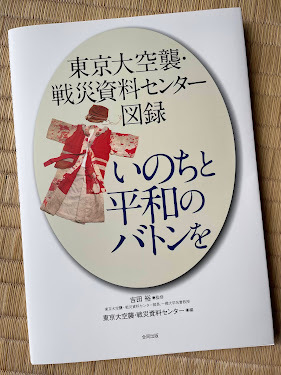
The Center opened in 1992 thanks to the determined activism of survivors and supporters and private donations for the purchase of the land and construction of the building. The Center was further expanded and improved in 2007, and updated again in 2020, and is a remarkable treasure of an institution, open to the public and often visited by school groups.
At the recent March 6 event, a survivor spoke of his experiences as an 8-year-old child during the air raid; grade six students from Tokyo who'd interacted with students from Nagasaki shared reflections on learning about war experiences in both cities; and both a scholar and a journalist spoke, as well as the head of the Center. The event can be viewed via Peatix until April 2. I picked up a copy of the recent publication by the Center 「命と平和のバトンを」(Passing the Baton of Life and Peace), pictured above, which is an excellent resource for personal and school libraries.
I also made a side trip to visit the Misuji neighborhood of Taitō-ku, to view the replica of a charred utility pole that had stood for years after the war as a reminder to never forget what happened; the actual pole has been moved to safely reside at the Edo Tokyo Museum. As I was contemplating the plaque, the pole, the history, a family of three generations paused, too, and the elders gently explained the meaning of the replica and what had happened to the young child, and we exchanged a few words.
The plaque by the pole's replica states the following (my rough translation):
During World War II on March 10, 1945 (Shōwa 20), during an American B29 air raid, more than 100,000 precious lives were lost, and all Misuji became a sea of fire. The misery of that night is etched into the remains of this utility pole that barely survived. Our hope is that the preservation of this telephone pole, as a living witness to that tragedy, may act as a prayer that wars like the one that led to this disaster never be repeated, and serve as a commitment to permanent world peace. March 10, 1988 Society for the Preservation of Burned Telephone Poles
In this difficult time in which peace still eludes much of the world, the sight of this family, this baton passing, brought hope to my heart (photo shared with their permission).

Just a few blocks away, runners were streaming down the street for the Tokyo marathon--indeed a welcome sign of peaceful days.
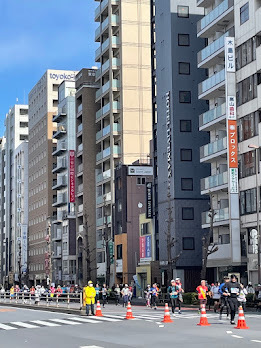
May we never forget. And may we do our utmost to preserve peace.
March 14, 2022
Tomo: Friendship Through Fiction
This year, March 10th--the day before the eleventh anniversary of the March 11, 2011 Great East Japan Earthquake and Tsunami--marked the tenth anniversary of the TOMO Anthology launch.
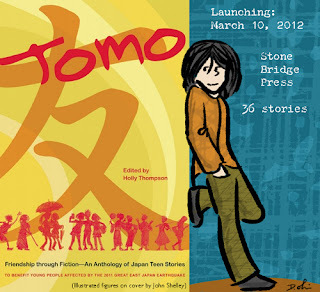
It's hard to believe that ten years have passed since Tomo: Friendship Through Fiction--An Anthology of Japan Teen Stories was published (Stone Bridge Press)!
For this anniversary, I reached out to contributors and gathered their reflections into a post on the TOMO Anthology Blog. Visit the blog to read comments from the publisher, myself the editor, and many of the contributors in the post TOMO Anthology 10th Anniversary! Words from Contributors.
While the TOMO Anthology is no longer in print, the Kindle E-book lives on--and with 36 stories, including ten in translation, it's perfect for middle school and high school libraries and classrooms, reading groups, and gifts to friends.
We hope you'll purchase a copy or two to help us continue TOMO's support. All proceeds from the TOMO Anthology go to programs that support teens in 3/11 impacted Tohoku areas of northern Japan.
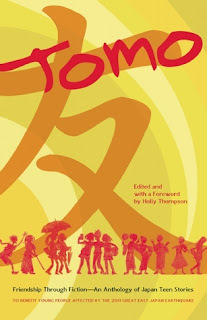
Tomo means friend in Japanese; thank you to all the friends near and far who helped this anthology become a reality.
October 7, 2021
Japanese Literature in English 2021
This September, once again, I taught two intensive courses at Yokohama City University--Japanese Literature in English and American Literature/Literature in English. Both involved squeezing fifteen weeks of content into five days, and both courses were taught remotely. I love teaching these courses, even though they're, well, intense!
In Japanese Literature, we opened by reading short stories in the 2020 Tree novel project--for kids "Story for You" and for adults "Day to Day." Next we read an excerpt from The Beast Player by Uehashi Nahoko, translated by Cathy Hirano, and listened to their riveting 2020 Printz Virtual Ceremony speeches. We read an excerpt from Tokyo Ueno Station by Miri Yu, translated by Morgan Giles that was featured on Words Without Borders, and watched the Japan Foundation New York event Yu Miri x Morgan Giles and enjoyed their conversations and readings in Japanese and English. We also identified marginalized groups in Japan and looked into which voices were being translated into English, and we read poetry in translation by Tian Yuan, translated by Kyoko Yoshida; Ishiwata Kimi translated by Jordan A. Y. Smith; and Tanaka Atsusuke translated by Jeffrey Angles--all of which were featured in Tokyo Poetry Journal, Volume 4. We also listened to an interview with translator Emily Balistrieri on NonNative Creative about the #NameTheTranslator campaign and talked about translations of Soul Lanterns by Shaw Kuzki and Kiki's Delivery Service by Kadono Eiko.

We read the opening chapter of Temple Alley Summer by Kashiwaba Sachiko, translated by Avery Fischer Udagawa. (Thank you to Restless Books for granting permission and a PDF file for the students!) We also listened to the Japan Foundation New York event Sachiko Kashiwaba x Avery Fischer Udagawa and studied publisher pages for this novel and other translated books.
We peeked at the Japan Board on Books for Young People catalog of recommended titles to see which Japanese children's and young adult books are recommended for publishers overseas.
And the final exam included selecting, reading and discussing one story translated from Japanese published in Words Without Borders.
On our last day of class we were fortunate to have a virtual visit from translator Avery Fischer Udagawa. Students had prepared a long list of questions about Japanese-to-English translation challenges, Avery's path to becoming a translator, and language and word choice decisions in Temple Alley Summer. Avery packed in her responses, and the students outdid themselves with thoughtful, detailed opening and closing words.
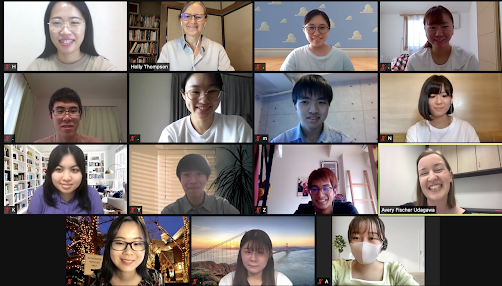 Japanese Literature in English with guest J>E translator Avery Fischer Udagawa
Japanese Literature in English with guest J>E translator Avery Fischer UdagawaHere are student recommendations for Japanese books for children, teens and adults to be translated into English:

1. "怪談レストラン” (Kaidan Restaurant) by Miyoko Matsutani (松谷みよ子) First of all, this series is one I read in elementary school and I was absorbed in it.... The stories are based on what we call “Japanese horror style.” In these days, Japanese horror things such as films and games are quite popular in the world.

2. しゅくだい (Shukudai / Homework) from いもとようこ by Yoko Imoto, picture book writer. This is a warm work that gives you a feeling of family love. I always cry when I read this book. The main character in this story is a boy with a newborn younger brother. His mother is always caring about his younger brother. I think this story will touch the hearts of many children.

3. いなばのしろうさぎ (Inaba no Shirousagi / Inaba’s white rabbit) from Yoko Imoto. This is one of the works in “Kojiki”, which is a traditional Japanese mythology. From this story, we can learn the importance of being kind and not lying to other people. Also, I think Japanese classical works or mythology is literary works that Japan should be proud to present to the world from historical and cultural perspective.

4. 卒業ホームラン (Sotsugyo ho-muran / Graduation homerun) by 重松清 Shigematsu Kiyoshi. This story tells something important to children, teenagers, and adults. Satoshi, 6th-grader, has not been able to be registered as a member for baseball match. His sister, Noriko, is a junior high school student. Although their father, Tetsuo, tells them to make effort to realize the dream, Noriko doubts his word, and Tetsuo also feels dilemma to his own word considering Satoshi hasn't been chosen for any matches despite his 6-year effort.

5. プリズム (Prism) by 百田尚樹 Naoki Hyakuta. Satoko works as a private tutor at the home of a wealthy family. A young man who lives in the house appears before her. Every time she sees him, his mood changes and he confesses that he has multiple personalities. I recommend it because I thought that characters with special circumstances are universal.
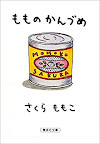
6.もものかんづめ (Momo no Kanzume / A Can of Momo) by さくらももこ Momoko Sakura. This is a memoir of Momoko Sakura, famous comic artist of “CHIBIMARUKO”. She wrote memories from when she was a teenager to adult with funny expressions. I recommend it because Japanese usual daily life and conversation are described, so when non-Japanese people read it, they will be able to know Japanese culture or perspective with enjoyment. Also, for people who have known “CHIBIMARUKO”, they will find what kind of person is the cartoonist of it and how her experiences connect to her works.

7. リバース (Reverse) by 湊かなえ Minato Kanae. I love mystery novels and I read many of them, and I think this mystery is different compere with the others, and the best. When you read the last sentence, you may get strong shock and say “What!?”. She doesn’t use difficult Japanese, so it’s easer to read, very understandable.

8. 阪急電車 (Hankyu-Densha / Hankyu Train) by 有川浩, Arikawa Hiro. This novel is developed of life episodes as loves and relationships of passengers of Hankyu Imazu Line trains, which runs in Hyogo Prefecture. Each character has different heart encounters and new stories are created. I recommend this book because I am interested in how the Kansai dialect in passengers' conversations will be translated into English. In addition, I recommend it partly because readers in foreign countries will be able to read the story with heartful mind, touching Japanese’ gentle sense of value in several episodes.

9. マタギに育てられたクマ (The bears raised by Matagi) by 金沢直美 Naomi Kanazawa. A man Matagi is in hunting communications in Tohoku mountains hunted a bear and noticed she had her two babies after doing that. He decided to raise them. Hunting is to kill but Matagi respects nature and animals and has a lot of strict rules about hunting. I want to recommend this nonfiction book because it tells us how to live sustainably. Now, we don’t have to hunt to get foods and can get foods from like supermarkets easily so it has been harder for people to respect and appreciate life.

10. ぼくはイエローでホワイトで、ちょっとブル (I am yellow, white and blue) by Brady Mikako (ブレイディみかこ). This book is about a boy who has an Irish father and a Japanese mother. He studies at the British Secondary school and is faced with racism and poverty. Although he has issues of forging his identity or being discriminated against, he is kind and quick-witted so he can live strong in the diversity, which tells us the importance of empathy and eliminating bias. I want people in today's bleak and diverse society to know about his flexible and kind minds and ideas.
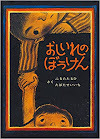
11. おしいれのぼうけん (Oshiire-no bouken / Futon closet adventure) by Truhi Yoshida (吉田足日), illustrations by Seiichi Tahata(田畑精一)in 1974. Two kindergarten boys who didn’t obey the teacher are shut into a closet. In the closet, there is an imaginary and scary world. Something like “Yōkai” named “Nezumi-Baasan” tries to catch them. They defeat it by cooperating and escape from closet. I think many Japanese have read it when they were young or have read to their child.
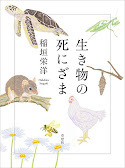
12. 生き物の死にざま (Ikimono no Shinizama / Living things and their ways of death) by 稲垣 栄洋 Hidehiro Inagaki. This book tells how various creatures are born in this world and pass on. It is a sad and moving story that depicts the "end" of life, such as for elephants, salmon, cicadas, and bees. They are all different from human beings, but each of the creatures anthropomorphized somewhere in the essay is so humane that it makes us empathize. At first, people will feel that it is a story far from human beings, but in the end we would think about human beings' own "death." This is a work that I would like people all over the world to read.
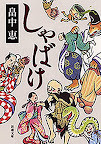
13. しゃばけ (Shabake / Worldly Desires) by 畠中恵, Megumi Hatakeyama. This book is the first book in the series. The era is the Edo period. The main character is Wakadanna (a young husband). He solves cases in cooperation with Yokai. Wakadanna is sick, so it is interesting to see the Yokai around him who are worried about him. This book describes how to make an old room and how to do business in the Edo era. I think it would be difficult and interesting to translate the state of the Edo period into English.

14. ある閉ざされた雪の山荘で (Aru tozasareta yuki no sanso de--At a closed snowy mountain hut) by 東野圭吾 Keigo Higashino. I don’t read books so much and it is sometimes hard for me to find it really fun to read a book. However, I couldn’t stop reading this book, so I hope this book will be read by many people all over the world, not only in Japan.
Whew! So many great suggestions.
Thank you to our guest and to this diligent and engaged group of students who joined my one-week intensive translation ride!
October 4, 2021
Parkinson's Poetry Event
My father lived with Parkinson's Disease for over twenty years, so when I learned about Parkinson's Poetry, I sent along two poems, "Kindling" and "Water Striders," which I'd begun writing a few years after his passing. These poems are both included in the Fall 2021 edition of Walking the Line--An Anthology of Parkinson's Writing.
The 2021 fall Walking the Line reading was recently held (virtually) in September. I was honored to participate (and, humbly, ended up as first reader).
I hope you'll listen to the Fall 2021 reading recording and read about poet Hal Sirowitz. And please share, so that more people living with Parkinson's, and their colleagues, friends and family members, can have a listen, too.
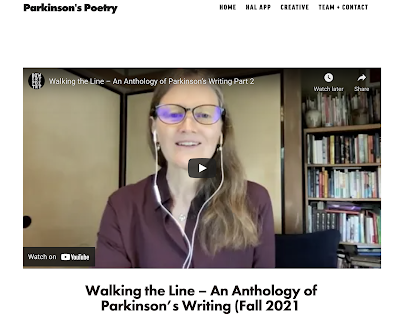 Fall 2021 Walking the Line Reading
Fall 2021 Walking the Line Reading The poems and stories in this recording brim with determination, humor, frustration, love, hope and courage. I was moved by every piece and honored to read and share the virtual stage with these writers.
With gratitude to the team behind Parkinson's Poetry: Susan Brennan, Hal Sirowitz, and Minter Krotzer.
And a P.S. My poem "Water Striders" is also recorded as a video poem here.
September 20, 2021
Creative Portfolios chapter in The Place and the Writer
Recently, The Place and the Writer: International Intersections of Teacher Lore and Creative Writing Pedagogy, edited by Marshall Moore and Sam Meekings, was published by Bloomsbury Academic in the Research in Creative Writing Series.
My chapter "Creative Portfolios: Adapting AWP Goals for EFL Creative Writing Courses in Japan" can be found on pages 107-128. In this chapter, I share my creative writing pedagogy shaped by years of classroom experience teaching fiction and poetry writing courses to Japanese students at Yokohama City University.
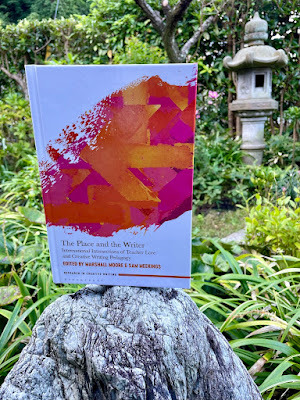
You can read the Preface and Foreword of The Place and the Writer and the full table of contents via the book's Amazon Look Inside feature. This volume contains fifteen chapters that explore creative writing teaching lore and intersections of language, culture and place; offers ideas for forging unique, localized contexts for creative writing; and presents ways to prioritize students' diverse identities.
I'm so grateful to the editors for encouraging me to submit, and to the creative writing instructors in Japan who responded to my questions about their EFL creative writing classroom pedagogy and suggested additional contacts for my research. And I'm deeply grateful to all of my YCU creative writing students who've shared their work with me over the years.
If you are a creative writing instructor, perhaps you might order a copy of The Place and the Writer for your university or personal bookshelves.
You can read recent issues of the YCU Creative Writing Literary Magazine Footprints, which I reference in my chapter, pictured below, on my blog here (2018, 2019) and here (2020-2021).
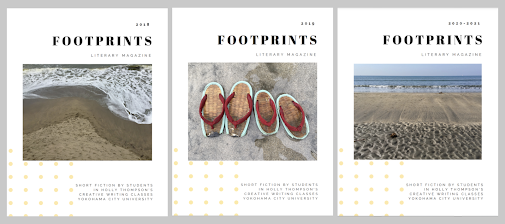
Creative writing courses are not yet common in Japanese universities. But I believe that alongside the opportunity to read and study literature, university students in Japan deserve the opportunity to create literature.
Rigorous creative writing courses offer students opportunities to engage in literary craft as innovators and to probe their own identity and relationship to the world. My big hope is that one day all students in Japanese universities will have access to undergraduate and graduate programs in creative writing, in both Japanese and in English.
July 9, 2021
Kumihimo Braiding
Last September, between Japan's coronavirus waves, I was able to squeeze in a visit to Asakusa Kiryūdō 桐生堂, a kumihimo workshop and store near Asakusa's Sensō-ji that dates back to the 1800s. With photographer Kenji Miura, and an editor from Ikebana International, we squeezed into a small braiding workroom to talk about the craft with Yuji Haneda, a fourth-generation kumihimo craftsman, and ask question after question.
Kumihimo is a centuries-old craft of braiding dyed and bundled silk threads. Kumihimo flat braids were used on samurai sword handles and to create sageo cords that attach to obi. Later kumihimo gained prominence as ties for kimono--obijime cords for tying wide taiko-musubi obi in place and for haori jacket ties for men. In addition to uses as kimono accessories, kumihimo braids are used as cords for netsuke and many other purposes, always adding a subtle touch of elegance.
My essay Kumihimo Braiding Now and Tomorrow about the Haneda family workshop was published this spring in Ikebana International Vol. 65 along with ten pages of stunning photos by the acclaimed Kenji Miura.
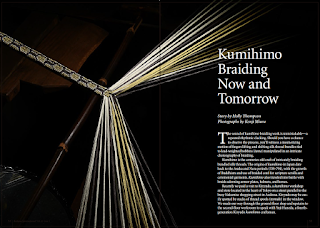
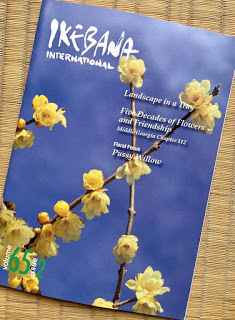
Craftsmen Yuji Haneda is determined to keep the kumihimo tradition alive and to help carry Kiryūdō into the next generation. He continues with traditional braiding colors, techniques, patterns and styles, and also experiments with new color combinations and products. Only for high volume orders does the shop use machines; otherwise they pride themselves on continuing with traditional hand braiding.
One product they developed recently that I now use daily (yes, Japan is in its fifth coronavirus wave) is a kumihimo mask cord. If you're in Japan, you can order them from Rakuten here.

May you have a chance to visit Kiryūdō and observe and appreciate in person traditional kumihimo crafts one of these days. And in the meantime, consider ordering some classy mask cords from Kiryūdō and stay safe, friends!
July 5, 2021
YCU Footprints 2020-2021
I'm so proud to share the 2020-2021 edition of Footprints, the literary magazine for the creative writing courses I teach at Yokohama City University.
Since 2003, I've taught English-language creative writing courses at Yokohama City University in both poetry and fiction, in addition to various other courses. Currently, my creative writing courses are offered in fiction only, so I incorporate poetry in all my other courses. Each spring I compile an annual anthology of student creative writing, and this anthology, Footprints, is now published online.
Most students in my YCU fiction writing courses have limited writing experience in English, and most have never written a short story since grade school. Yet my creative writing semester courses include reading short stories, studying fiction craft, drafting multiple story starts, developing one story to completion, revising, workshopping, editing and polishing. With limited contact hours (courses in Japanese universities typically meet for one ninety-minute class per week for fifteen weeks), these courses are rigorous sprints as students learn to craft using fiction elements: voice, plot, characterization, dialogue, setting, motifs and more. Yet my students--Japanese nationals, returnees, exchange students--always amaze both me and themselves as they evolve into adept storytellers and English-language fiction writers.
Here, with permission of Yokohama City University and the student writers, I present Footprints 2020-2021. (See Footprints 2019 and Footprints 2018 in this post.)

Have a look! Read Footprints 2020-2021.
And below are some teasers for each story.
Footprints 2020-2021 Contents
In Grey Figures by Hikari Abe, a student encounters a person from an old photo who might offer a clue to her past.
In Unopened Room by Shoya Abe, a boy enters a grandparent's closed-off room, which reveals there is some sort of family secret.
In The Golden Watches by Kanon Hayakawa, a café worker steals a watch that is identical to one on the wrist of a customer she admires.
In Kikuna Station by Miku Hoshi, a graduating high school student hopes her friend might become more than just a friend, and she pins her hopes on a class reunion.
In trip by Yukimi Katada, a young company worker flees Tokyo for her hometown but encounters an odd person in the seat beside her on the Shinkansen.
In Sudden Sadness, Sudden Happiness by Takahiro Kimura, a news writer cannot understand why an old acquaintance disappeared on him.
In Pen Stand by Yoshitaro Kubo, a child admires a grandfather's pen stand, but has never understood its significance.
In Pointe Shoes by Moe Kunifuji, a determined young ballet dancer asks Santa to bring him pointe shoes and when he receives a robot toy instead, tries out his sister's shoes in secret.
In My Last Chance from Santa by Akbar Mamedaliev, Ken and Risa enjoy each other's company during their café shifts, until Risa suddenly announces she's getting married.
In Orange Lights by Kurumi Mori, a university student returns to her hometown and finds that her family has changed in both subtle and obvious ways.
In Morning Battle Versus an Outcast by Runa Motoki, something black and shiny about the size of an eraser lies in the middle of the floor--it has legs and two antennae.
In The Blackwolf Festival by Miko Nagahama, a caravan family stops in a village at the time of the annual Blackwolf Festival when offerings are made in hopes of protection for another year.
In The Mirror by Yuka Nagano, Shiori finds her mother talking into a small mirror, but soon she observes that her mother no longer behaves like her mother.
In The Scent of Lies by Meria Nagasawa, what had seemed like love turns out to be a cruel trick that Mari can't seem to forgive.
In Maru’s Magic by Momoka Naito, Mai wishes she could be like other couples out enjoying Christmas Eve, but her only companion is her dog Maru--then Maru intervenes.
In Be the Cure by Mizuki Saito, Emi seems to have the ability to cure others, but this ability comes at a significant cost.
In Giant Monster of the Summer by Yuji Shirabe, a budding young artist takes a break for a cool drink and realizes something menacing is watching him, which leads to a sweltering chase.
In Change by Mirai Suwa, a woman with negative body image collides with a co-worker and finds there has been a body switch.
In See You Again by Miku Umekawa, a meandering photographer encounters many cats, including one that leads to an odd café and a girl... or is it a cat?
Enjoy reading Footprints!
February 18, 2021
Spring Picture Book Courses
Since 2015, I've been teaching picture book writing courses at GrubStreet, Boston's creative writing center. I've taught these classes every which way--face-to-face, remote, online, intensives, 6 weeks, and 8 weeks.
This spring, I'm pleased to offer these two picture book writing classes.
6 Weeks, 6 Picture Books, a generative course for those starting out, begins March 3 and runs for 6 weeks.Picture Book Revision, for experienced picture book writers, begins April 21 and runs for 8 weeks.
Both courses are online, taught via the Wet.Ink platform for writing workshops, and scholarships are available.
Please share with your picture book loving creators and friends throughout the world!
And here are just a handful of the many picture books I look forward to referencing and discussing in these spring 2021 courses.

Care to join us?
September 30, 2020
Two Picture Book Translations
Over the past year, I've had the opportunity to work with Miyoshi Town (三芳町) Library in Saitama translating two picture books of local history. Thank you to Avery Fischer Udagawa (via JBBY) for sending this translation job my way!

Both books were created in conjunction with the town's Yomi-ai Read Together initiative:よみ愛・読書のまち, and I worked closely with librarian Tomoko Shirota throughout the translation, editing and copyediting process.
In June 2019, I visited Miyoshi Town to attend a performance of Chikumazawa Kuruma Ningyō puppetry by the local troupe and to gain some first-hand understanding of this performance art. Many people know of bunraku puppetry, but few are familiar with kuruma ningyō puppetry in which just a single puppeteer, seated on a small kuruma wheeled cart, controls each puppet.
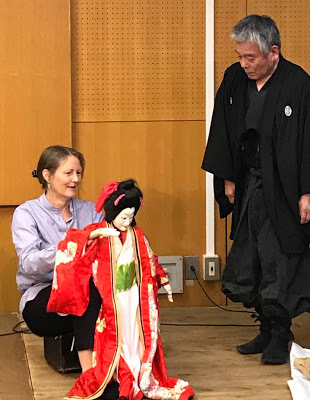
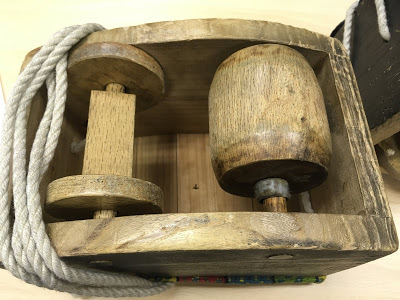
This puppetry style developed in the Tama region, and during the Meiji Era, the Maeda family of Chikumazawa began performances. However, as times changed and films and other forms of entertainment gained popularity, demand for puppet shows waned, and the last performance was held in 1921. Kuruma ningyō was put to rest, all but forgotten. Then in 1971, wicker boxes containing puppet parts, costumes, and carts were discovered in a Maeda family storeroom. Fortunately there were two healthy elderly individuals in the community who knew the art of kuruma ningyō puppetry and could train others. Now the Chikumazawa Ningyō Preservation Society troupe performs annually using original puppets, costumes and stories, and the performance art is taught to children in the region. This style of puppetry survives in just three places in Japan: Hachioji City, Okutama, and Chikumazawa in Miyoshi Town.
The picture book about this type of puppetry, かえってきた竹間沢車人形 (Kaettekita Chikumazawa kuruma ningyō; English title The Puppets Are Back! Chikumazawa Kuruma Ningyo Puppetry) written and illustrated by Noriko Sagesaka, is told from the vantage point of young Yoshiko who helps her father discover the puppets and follows along as he learns to manipulate the puppets and ultimately perform on stage. I was fortunate to meet the real Yoshiko and her father during my visit to Miyoshi Town!
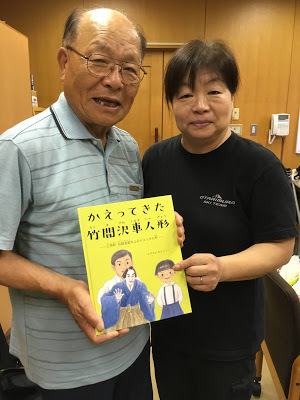
I loved the work of translating this book, especially the rich back matter and the interior "Look Inside!" and "Make It Move!" full-spread sections.
The second book おいしくなあれ富のいも(Oishiku naare tome no imo; English title Grow, Grow, Grow, Tome Sweet Potatoes!) by Hiromi Watanabe and illustrated by Hiroko Takai was actually the first book published in this reading initiative series. This book focuses on a type of sweet potato cultivated in the Kawagoe area of Saitama. During my visit to Miyoshi Town, I was able to visit the Santome Shinden fields--long rectangular land allotments created some 300 years ago combining space for farm houses, forest for leaf compost, and long fields for the sweet potatoes famous in this area. I was fortunate to meet the farmer of the story, which features a fictional grandson Daichi learning about the growing cycle and the traditional Edo-era method for creating satsuma-doko seed beds for temperature control.

In the story, Daichi plants his own seed potato in the fields, and in autumn during the fall harvest festival he savors the potatoes of his labor and looks forward to creating the seed bed again in early spring.
This book, too, is fiction that features child-friendly nonfiction elements: a full spread about the traditional leaf compost method, plus back matter about Miyoshi Town--home of the famous Tome sweet potatoes.
Miyoshi Town was selected to be an Olympic Host Town, and these books were translated anticipating an influx of tourists to the area this summer. Alas, COVID-19 interrupted those plans! At this time, the English-language translations are only available through special order via the Miyoshi Town Library. Librarians in Japan--PM me if you are interested in a copy!
As a picture book author, I love both crafting and reading fiction picture books that also weave in rich nonfiction contents. And I am always excited to work on projects about the arts, agriculture, rural life and nature. I hope to do more picture book translations in the future!



